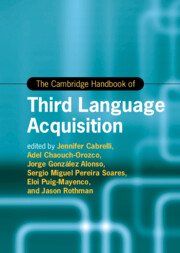Book contents
- The Cambridge Handbook of Third Language Acquisition
- Cambridge Handbooks in Language and Linguistics
- The Cambridge Handbook of Third Language Acquisition
- Copyright page
- Contents
- Figures
- Tables
- Contributors
- Introduction Multilingualism
- Part I Theoretical Approaches to L3/Ln
- Part II L3/Ln across Linguistic Domains
- Part III Becoming and Staying Multilingual at Different Ages
- Part IV L3/Ln in Action
- Part V L3/Ln and Cognition
- 20 Multilingualism and Cognitive Control in the Brain
- 21 Multilingualism and Cognitive Reserve
- 22 The Effects of Multilingualism on Brain Structure, Language Control and Language Processing
- 23 Mechanisms of Cognitive Aging in Multilingualism
- 24 Multilingualism and Language Impairment
- Part VI Research Methods in L3/Ln
- Index
- References
20 - Multilingualism and Cognitive Control in the Brain
from Part V - L3/Ln and Cognition
Published online by Cambridge University Press: 13 July 2023
- The Cambridge Handbook of Third Language Acquisition
- Cambridge Handbooks in Language and Linguistics
- The Cambridge Handbook of Third Language Acquisition
- Copyright page
- Contents
- Figures
- Tables
- Contributors
- Introduction Multilingualism
- Part I Theoretical Approaches to L3/Ln
- Part II L3/Ln across Linguistic Domains
- Part III Becoming and Staying Multilingual at Different Ages
- Part IV L3/Ln in Action
- Part V L3/Ln and Cognition
- 20 Multilingualism and Cognitive Control in the Brain
- 21 Multilingualism and Cognitive Reserve
- 22 The Effects of Multilingualism on Brain Structure, Language Control and Language Processing
- 23 Mechanisms of Cognitive Aging in Multilingualism
- 24 Multilingualism and Language Impairment
- Part VI Research Methods in L3/Ln
- Index
- References
Summary
Multilingualism affects cognitive, behavioral, and neural function across the lifespan. Here, we review the neuroimaging literature on bilingualism, multilingualism, and executive functions, focusing on three multilingual groups who rely on language control to varying degrees to overcome competition from other languages: third-language learners, multilingual adults, and simultaneous interpreters. In third-language learners, changes in brain regions underlying executive functions occur during the early stages of acquiring another language. In multilingual adults, effects of language experience reflect a qualitative difference between monolingual and multilingual processing rather than cumulative effects of increased linguistic knowledge. In simultaneous interpreters, changes in gray matter volume and white matter integrity are found in areas underlying language selection and executive functions, reflecting neural efficiency due to experience with rapid translation. The implications of these findings for our understanding of multilingualism and the value of moving beyond the monolingual–bilingual dichotomy are discussed.
- Type
- Chapter
- Information
- The Cambridge Handbook of Third Language Acquisition , pp. 519 - 554Publisher: Cambridge University PressPrint publication year: 2023

